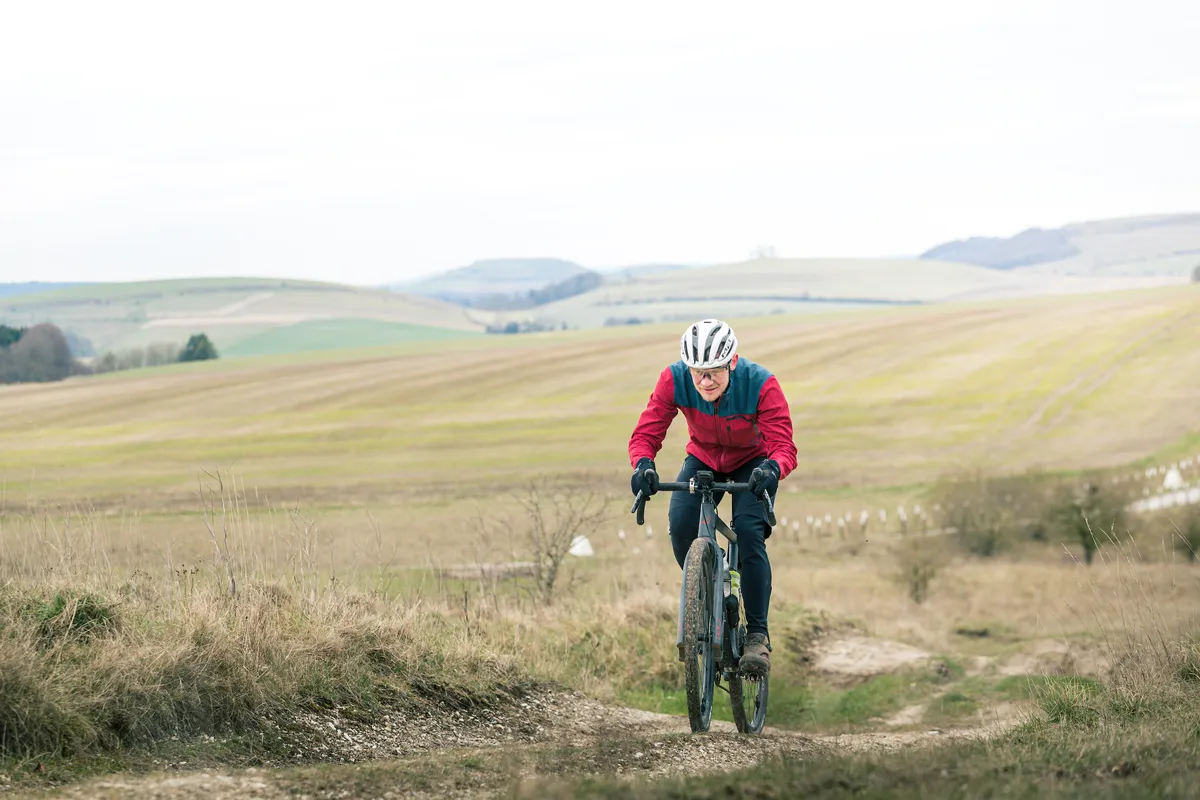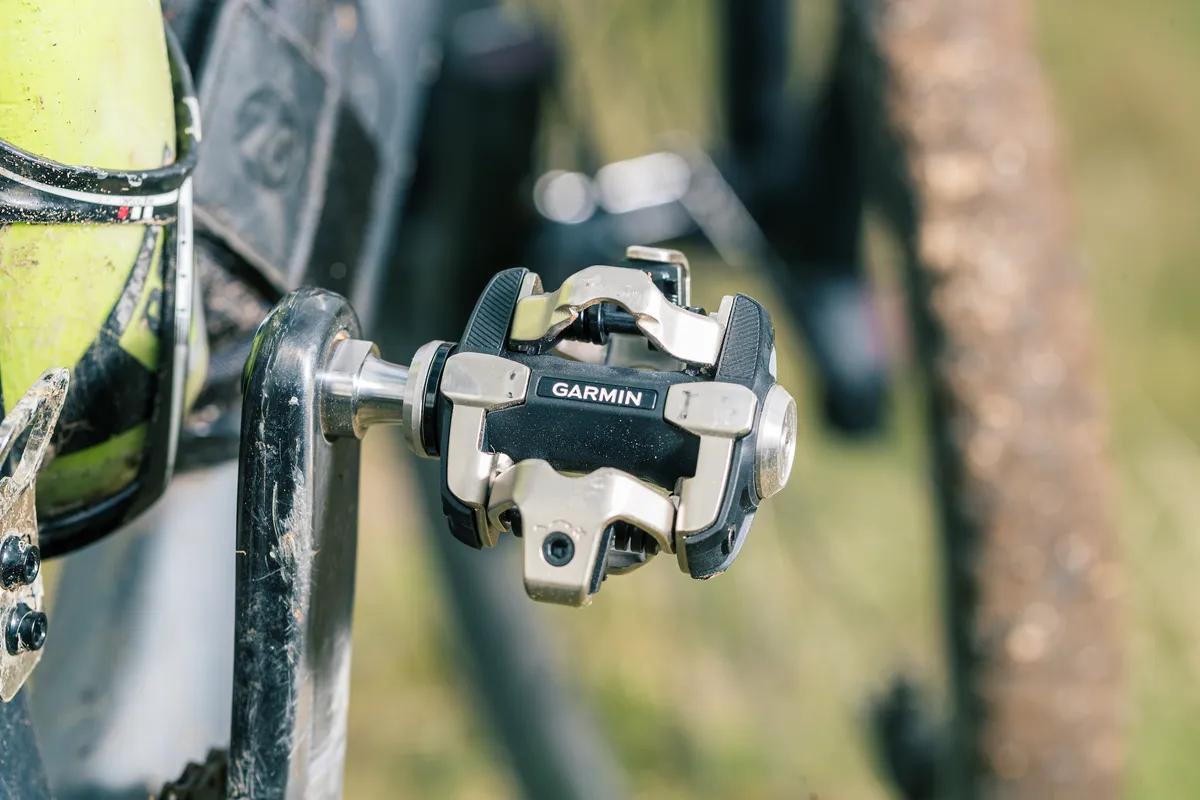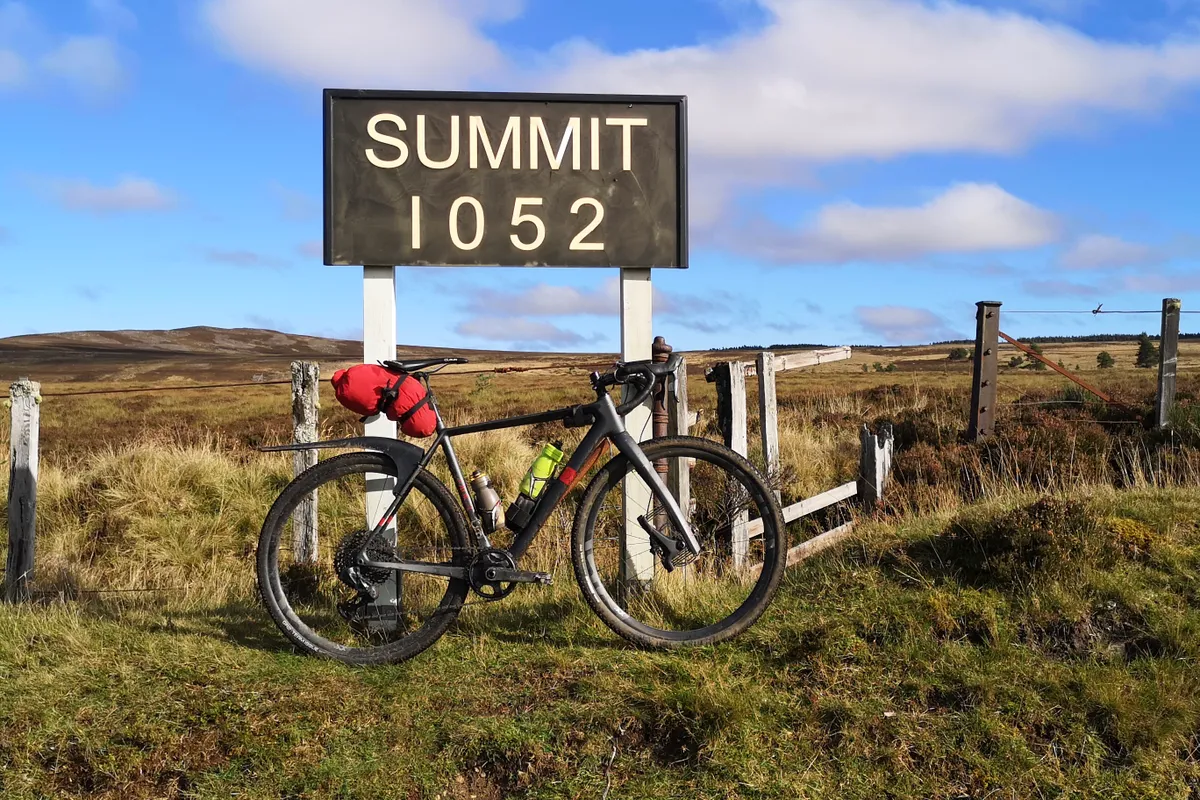The Lauf True Grit is built for gravel racing: big days, covering long distances, over a multitude of dirt surfaces.
It’s not designed to carry all your bells and whistles, but still manages to blend an element of comfort into its relatively racy demeanour, with generous front-end-height adjustment if you don’t have pro-Tour-esque flexibility.
While the frameset is nicely finished, with numerous neat touches, it’s the Grit SL fork that steals the show.
This leaf-sprung suspension fork offers 30mm of travel, which is enough to take the sting out of the dirt roads, without impacting too much on the bike’s dynamic geometry.
It’s incredibly good at reducing handlebar buzz, too, which over long distances adds to fatigue, and helps with bigger hits, but with 30mm travel, there’s only so much it can be expected to handle.
This model is the second tier of the four-model range and features DT Swiss alloy hoops wrapped in Maxxis Rambler tyres, a SRAM Force/XX1 AXS wireless 1x groupset with a 10-50t cassette, and a smattering of FSA and Lauf finishing kit.

Lauf True Grit Race AXS long-term review update four

While it might not be entirely fair to say this, mountain biking often, because of the trail network in the UK, takes place in Forestry Commission commercial pine forests, and thus aesthetically varies very little.
On a sunny day, take a picture of a pine forest and you'd be hard-pressed to tell the difference between summer and winter – especially as puddles in the UK are a near year-round feature.
Riding the Lauf all year round, often not in a commercial forest, means I see the seasons changing whenever I ride.

This is exacerbated when I ride in the same place, a month or two apart. As featured in my third update, below, I spend regular, but not consistent amounts of time in Aviemore, Scotland. And it was here that I spent my Christmas and New Year.
Deep down, I was hoping for heavy snow, mostly because one of Scotland's main ski resorts is a mere couple of miles up the hill, and I wanted to fish out a pair of planks and go roost some pow-pow.
But, instead, I was treated to a chilly high-pressure system that hadn't dumped much snow, and so I donned some thick gloves, my Sportful Supergiara Puffy and some Nukeproof riding trousers, and headed into the hills behind town for a few achingly beautiful, and achingly cold rides to burn off the Christmas turkey (well, venison actually).

Having spent plenty of time testing road bikes for Cycling Plus, I've dodged my fair number of icy patches on tarmac. With under 40psi in my Maxxis Rambler (f) and Bontrager GR2 (r) tyres, I still skirted around the most glass-like patches of ice without issue, but it was refreshing to be totally comfortable scooting over frost patches, or bits of fireroad where stones and grass poked through an underlying layer of ice, safe in the knowledge that I was fairly, er, safe.
I've only recently been letting my tyres down so low on the True Grit. I guess I'm fairly happy rattling over rough surfaces at closer to 50psi, especially considering the squish afforded by the Grit fork.

The smooth rolling of sub-40psi is certainly alluring. That said, I noticed that on-tarmac handling is compromised. Maybe it's the combo of the supple tyre, and the fork's suspension and lower lateral stiffness than a traditional fork, but at those pressures the feel between tarmac and bar is just too vague for my tastes. I'll be keeping the rear hovering around 40psi for now, but the front is back up to around 48psi.
Going forward
At this time of year, we traditionally say goodbye to our long-term bikes. However, I'm hoping to keep hold of the True Grit for a little longer, into 2022. I've plans in the works that'll see me riding the bike a lot later in the year, and in the run up there are a few modifications that'll be needed. As such, I'll keep my long-term reports rolling in every couple of months.
Lauf True Grit Race AXS long-term review update three
A week in Aviemore, Scotland, where my girlfriend lives, gave me an opportunity to get back on the Lauf, after spending a fair bit of time riding my Marin El Roy.
I’d been feeling like I’d ignored gravel, what with the Merida Ex Enduro (Powered by Shimano Steps) and then a two week holiday in the Alps, where I ragged the El Roy as much as I could before heading home to a UK winter.

So, with the Cairngorms having mile upon mile of prime gravel, it was an easy decision to chuck the Lauf in the back of the van as I cruised far up north.
I was hoping to catch the last of the summer’s warmth, and perhaps a cheeky few dry trails, too, before the inevitable six months of grim puddle dodging.
With little actual knowledge of where I was going to go, I jumped on Komoot to plan out a day’s ride. Having explored a little of the area in the past, I knew there was a fair risk of trudging through mud, even at the best of times, and with my other half working, I also knew there’d be no rescue party until at least early evening if things went a little wrong.
So I planned a 90k loop, avoiding the highest bits of the Cairngorm plateau, and packed a saddle bag with a full set of waterproofs, some synthetic insulation and plenty of snacks.
Inevitably, I set off late. But not before I’d popped to the local bakery to pick up some Scottish delicacies. More on those later.
I had just my annoying Garmin Virtual Partner for company (seriously, Garmin, why can’t I turn it off on my 830?!), goading me into riding faster than my cold legs would go.
But, as always seems to happen on longer rides, the first few kilometres of light, traffic-free gravel out of town flew by, lulling me into a false sense of security. I mean, if the first 3km was that easy, I’d be home in no time!
My route took me out of town on a wide NCN cycle path, before taking a diversion through an undulating forest. On Komoot I couldn’t tell the difference between fire road and singletrack, but thankfully this narrow sliver of trail through the trees was all passable on my skinny rubber.

From there, I enjoyed a mix of tarmac, farm track and, eventually, classic Scottish gravel double track through and past Carrbridge, and on to the climb up and over the hills to Lochindorb.
This section of the ride was why I’d packed so much. I envisaged a desolate slog, through a windswept bog, pushing for hours and cursing my route planning ability.
As it was, it was a fairly steep, but entirely rideable and incredibly scenic rough doubletrack over the hill with a little dip and then a steep final pitch to 360-degree views of the mountains.
If I wasn’t bathed in sweat, thanks to a full complement of windproof gear and winter shoes, I’d have been loving life.

The 4km descent to the loch was a welcome relief and, at the bottom, I decided approaching 40km was a good time to enjoy my lunch by the shores.
I was joined at my lunch spot by the last of the summer's midges; their presence an itchy and unwelcome addition to my macaroni pie and empire biscuit – Scottish fayre at its finest. I decided to save my Irn-Bru until later, for another insulin roller coaster later in the ride.
The Dava Way was next on my route, an arrow straight double and then single track, reminiscent of the Fosse Way near my native Bristol – an iconic piece of South Western gravel.
I felt very much at home, not needing to steer for the best part of 8km, but I did take a quick detour to see a gorge and Huntly’s Cave, where two generations of the Gordon family hid from those they’d annoyed in the mid to late 1600s. I'm fairly confident I enjoyed my visit more than they did.
Having eventually found some corners, I headed back into the woods, before picking up a mesmerising gravel track alongside the River Spey towards Grantown-on-Spey, with the sun glistening off the gently turbulent surface.
The October sun was positively beating down on my largely windproof, entirely black attire and, feeling rather dehydrated, I rejoined the insulin express with my can of Irn-Bru, very much shaken, not stirred, after four hours of gravel tracks.
If you're wondering what Irn-Bru is, well, it’s a Scottish version of Mountain Dew, but luminous orange instead of luminous green, and likely just as nutritious.
With sugar coursing through my veins, I followed the largely flat Speyside Way out of Grantown-on-Spey. While there were no hills to hinder my progress, it did seem like death by a thousand gates.
However, having shunned my Virtual Partner, I was in much better company with Mark Knopfler’s Dire Straits powering me along the tracks via Nethy Bridge and Boat of Garten.
By the time I’d crossed the bridge at Boat of Garten, both the macaroni pie and Irn-Bru’s energy supply was dwindling, and I’ll admit to looking forward to getting back to Aviemore, where I knew a chip butty was on the menu.
I soon re-joined my outbound route, the wide gravel track’s corners revealing the mountains I’m familiar with seeing in Aviemore. While those first few kilometres flew by, the final few took more effort. But, on entering the outskirts of Aviemore, it was great to hit the Aviemore Orbital (yes, like any metropolis, Aviemore has an ‘orbital’) and then the highstreet back.
The ride had been a resounding success, though.
While I'd worn far too many clothes, I didn’t end up pushing anything or get lost or find myself axle-deep in mud or water. I count that as success any day!

As for the Lauf? Well it performed faultlessly.
SRAM’s AXS gears did their job without grumbling, the Grit fork killed buzz as it should and the Maxxis Rambler at the front, paired with a Bontrager G2 at the back, rolled efficiently and comfortably, backed up by that shock-damping Canyon post.
Lauf True Grit Race AXS long-term review update two
If it ain't broke, don't fix it.
That's pretty much been the story since my last update because the Lauf continues to chug along very nicely indeed.
2020 was a big year for cycling for me with all the free time during lockdowns. This time last year I was banging out 100 to 150k rides weekly, with occasional jaunts of up to around 200k. I was hoping this year would continue in the same vein because I had a few long-distance goals I wanted to hit, but that hasn't been the case so far.
There was a 178km mountain bike ride a couple of months back, though, which would have been faster on the Lauf, but I rode a Specialized Epic in preparation for an attempt a couple of weeks later to do the West Highland Way in one day. Sadly, thanks to clothing/feeding/weather/time, I pulled out halfway. I'll be back, though.
But back to the Lauf…

Like a lot of cyclists, I'm at times pretty conflicted about driving to and from rides – riding from home is much simpler and, of course, it's one less vehicle on the roads – but as good as Bristol is for riding, the mountain biking available from my door can get a bit stale.

So the Lauf has offered me a great opportunity to take an evening spin and remind me that there's plenty of good riding to be found locally, if you're happy to have a dig on Komoot and accept that you're not going to be 'shredding the gnar'.
While it's a good 10k before anything exciting happens, at least the Lauf is an efficient way of crossing ground and once out on those gravel roads, they're definitely worth the trip.

I also injured myself earlier this year, so the Lauf has been a useful tool in my recovery from a (potentially, the doctors can't 100 per cent tell) fractured wrist, sustained when I ran out of talent on a mountain bike.
With anything rough off the cards for a few weeks, the Lauf has made riding over terrible roads local to me relatively smooth and much kinder on the wrist, thanks to its tyre volume and Grit fork, with its incredible road buzz-killing abilities
Lauf True Grit Race AXS long-term review update one
I've been rattling around on my Lauf for a good few months now, which has provided the perfect antidote to the mountain bikes I test day-to-day.
Rattling is perhaps too negative a sounding word, it's just that a 45c gravel tyre in comparison to a 2.6in wide one gives a fairly different ride experience!
As hinted at in my original update, see below, I've now made one or two changes to the bike, the first of which is the addition of the Canyon VCLS 2.0 seatpost.

Leaf-sprung seatposts
With the front end of the bike benefitting from the Grit suspension fork, I was finding the feeling of the bike a little unbalanced, and, truth be told, a little uncomfortable on hard-packed rough tracks.
Much like the fork, the Canyon VCLS 2.0 seatpost I've fitted is a two-piece leaf-sprung unit, designed to flutter backward and forward, to take the sting out of trail chatter.

Yes, a wider tyre in theory would be a great option, however clearance at the back of the bike is limited, and while Lauf says a 45c tyre can be fitted in there, I reckon that's only going to work in dry, dusty locations.
Here, in the UK, a 40c tyre collecting and then clogging the rear end of the bike is a frequent occurrence. As such, it's this skinner rubber I'm having to stick with.
So, what's the seatpost like? Well, it makes a noticeable difference for sure. So much so that on my first ride with it I was constantly checking the rear tyre for a flat.

There's a bit of bum-bounce when pedalling on roads but off-road this disappears. High-frequency buzz is greatly reduced, which not only improves comfort over an individual bump but also helps minimise fatigue on long slogs.
Setting the post up is a bit of a hassle because the angle of the saddle is defined by the relative position of the two halves, which is secured with a small grub screw located well inside the frame's seat tube. As such, small adjustments require the post to be removed.
However, once set, it's pretty much good to go.

Wheely good hoops
The other main swap has been the wheels.
The original wheels fitted to the bike were a pair of DT Swiss XR1501 alloy hoops. However, Lauf itself has recently moved over to fitting E13's wheels from stock. As such, I was sent a set of its latest carbon XCX Gravel Race wheels.
These wheels are a touch deeper than the DT wheels at 28mm, and are also a little wider internally, coming in at 24mm. Subsequently, the tyres I have on there have a little more volume.

Before reviewing the wheels I'd like to spend more time on them, but so far that extra depth has had little effect on the handling of the bike, apart from perhaps in the strongest sidewind gusts where there's obviously a little more deflection.
Despite their depth and carbon construction, I've not found them uncomfortable or harsh either, which is no bad thing.

Pick-up from the rear hub is good and they have a nice muted buzz to them. I have had a couple of freehub engagement issues with my pair, though. However, these are pre-production samples that came with slightly thicker grease than production hubs would.
I stripped the hubs down (easy to do), cleaned them out, and replaced the grease with a lighter-weight lubricant I had in the garage, and, so far, this seems to have done the trick.

My only other real addition to the bike is a new Garmin Flush Out-Front Mount. Why? Well, it allows for the fitting of a Backup Battery, which connects to my Garmin 830 through the centre of the mount for super-slick, super-long battery life for super-long days out. Swish.
Older updates continue below.
Lauf True Grit Race AXS specification and details
The True Grit frameset is an all carbon affair, and has fully guided internal cable routing for a 1x drivetrain. Though the frame will take a gear cable, this version of the True Grit uses SRAM’s wireless AXS groupsets – as do the top-level Ultimate (£5,990) and third-tier Weekend Warrior AXS (£3,390).
Force level shifters are joined by an XX1 AXS derailleur and 10-50t cassette, driven by a Force 1 chainset with a 42t ring. SRAM Force calipers, linked to those shifters, pull on 160mm rotors, front and rear.
Lauf’s own Smoothie bar dominates the cockpit. This uses a glass-fibre top blended into carbon-fibre drops. The glass fibre section of the bar is designed to give a little more flex and buzz reduction, while the carbon sections save weight where this buzz reduction isn’t needed.
The Grit SL fork at the front relies on a dozen glass-fibre leaf springs to provide the 30mm of un-damped travel, with a pair of rubber stoppers preventing a super-harsh bottom-out. It relies on a 100 x 15mm axle to secure the front wheel.
Currently, the bike is sold with DT Swiss XR1501 alloy wheels, fitted with 40c wide Maxxis Rambler tyres.

The rear chainstays are reasonably boxy, boosting pedalling stiffness, while the slender seatstays are there to give a little comfort. At the back there’s a 142 x 12mm axle, along with a chainsuck plate to protect the chainstays.
Lauf has equipped the frame with four pairs of bosses: two within the frame triangle for bottles, one under the down tube for either extra water or storage, and a pair in front of the stem for a bento-box, ready for longer races.
Lauf True Grit Race AXS specification
- Sizes (*tested): XS, S, M*, L, XL
- Frame: Carbon
- Fork: Lauf Grit SL 30mm
- Shifters: SRAM Force AXS
- Derailleurs: SRAM XX1 Eagle AXS
- Cranks: SRAM Force 1 cranks (1×12)
- Wheelset: DT Swiss XR1501
- Tyres: Maxxis Rambler 700 x 40c
- Brakes: SRAM Force 160/160 rotors
- Bar: Lauf Smoothie 42cm
- Stem: FSA V-Drive 6-degree,
- Seatpost: FSA SL-K
- Saddle: Ritchey Trail WCS Titanium
Lauf True Grit Race AXS geometry
At 182cm tall I sit between a Medium and Large on Lauf’s sizing guide. Personally, I prefer a slightly more aggressive fit on a bike, and have slightly shorter legs for my height, so chose the Medium. This gives me both extra seatpost extension for comfort and a lower front end.
This means the frame reach is 394mm and reach to handlebar length 456mm. Seat tube length measures 542mm, while the head tube is 133mm and there's a 65mm bottom bracket drop.
Chainstays are 425mm long and there’s a 1,040mm wheelbase. The head angle, with 6mm of sag, is 70.5 degrees and there’s a 72.5-degree seat angle, designed for use with a zero-layback seatpost.
- Head angle: 70.5 degrees
- Seat angle: 72.5 degrees
- Chainstay: 425mm
- Seat tube: 542mm
- Top tube: 571mm
- Head tube: 133mm
- Bottom bracket drop: 65mm
- Wheelbase: 1,040mm
- Stack: 561mm
- Reach: 394mm
Why did I choose this bike?
I’m not going to sit back and say the True Grit was an unknown quantity – far from it. I’ve known the team at Lauf since its first mountain bike fork came out, and have followed the brand's growth from a manufacturer of a very niche mountain bike product to a company with a range of products and two bikes in its range – last year Felix rode Lauf's Anywhere as his long-term bike.
I was also lucky enough to ride the Grit fork when it launched, and later the True Grit on the launch event in Iceland and longer term after the event

So, with the offer of running the latest version of the bike with an updated Grit SL fork and new componentry, I didn't hesitate to say yes.
I love gravel riding. I ride mountain bikes a lot for work (and adore MTBing too!), but gravel gives me something else that wider tyres can't – easy, local access to great riding, big miles, and long days in the saddle.
I like a racier bike, too. When I ride road bikes, I gravitate towards the racy, more aggressive end of the spectrum. So, even without prior knowledge of Lauf's bikes, the True Grit would naturally sit towards the top of my shortlist.

Furthermore, I really believe suspension has a place on a gravel bike. It’s as much about comfort as it is about control. And, coming from the mountain bike side of things, it feels utterly natural to have a springy front end.
There are various suspension options out there for gravel; whether it’s an IsoSpeed decoupler from Trek, FutureShock from Specialized, Fox AX, SR Suntour GVX or Lauf's Grit.
Personally, I prefer the concept of a suspension system that isolates (to some extent) the front wheel from the frame. Less vibration is transmitted through the frame, so the overall bike rides smoother, and thus (in my eyes, at least) faster.
I don’t think the Grit SL is a perfect fork, though, and will cover this in more detail in my impressions below, but I do think it’s got a lot going for it – and it's certainly a subject of debate within the BikeRadar office. However, we’ll leave those arguments for another day.
Lauf True Grit Race AXS initial set up
Given I know the True Grit fairly well, set up has been easy. There’s no adjustment needed on the fork and, in terms of bar and saddle height, I’ve set the bar low-ish, but not quite slammed, and the saddle at my preferred pedalling height.
I’ve got the brake hoods angled in slightly, as is my preferred feel.

Tyre pressures are set to the low 40s of PSI – high enough to avoid feeling sluggish on tarmac, but low enough to give grip and an element of comfort on dirt.
I’m currently running some Ritchey pedals, but often swap between pedals for a set of Shimano XT Race pedals and something else I can’t talk about right now. But they all use Shimano’s SPD cleat system.
Lauf True Grit Race AXS ride impressions
The initial photos for this bike were taken a couple of days after I received the bike, back when the sun was shining and the bales were still in the fields. Since then we’ve had a long British winter that’s only just on the wane.
Fortunately, in between my Trail Bike of the Year testing, I’ve been able to get out on the Lauf a fair bit and have continued to explore Bristol’s surroundings, taking in all the local sights – from stately homes to south-west England's most popular fly tipping sites.
I’m getting to grips with Komoot, too, using it as a tool to search out alternative routes to the main roads in and out of the city, whether that's via cycle tracks, single tracks or dirt tracks.

The True Grit has, largely, worked as expected. The shape of the bike works well for my needs, proving comfortable in sizing and allowing me to adequately get into those more aero shapes that work well on road sections.
Off road I’ve found the handling to be sharp enough to navigate over or around rocks, roots and pot-holes, and still give me the confidence to let loose on the brake levers and carry speed on descents.
I do think the longer geometry and the fork contribute here. There’s inherent stability from the length, while the front wheel is better able to track the ground, with both the tyre’s volume and the fork’s suspension keeping the whole bike calmer.
In future updates, I’ll talk more about the geometry and handling.
The Maxxis Rambler tyres seem to be a decent all-rounder. On the road, they don’t feel too sluggish and their relatively continuous central tread rolls fast, while the carcass seems supple.
In deep or slippery mud it's inevitable that they don’t always hold traction particularly well, but that’s a trade-off I’ve been happy to make all winter. My only complaint with the tyres is that their bead seems fairly baggy on a number of wheels I’ve tried, and getting them to pop into the rim’s bead tubeless can be a frustrating exercise.

I’ve also been very impressed with the Force/XX1 AXS drivetrain, and more so than I have in a mountain bike context. The sequential, flappy-paddle shifting setup is incredibly intuitive and, thus far, shifting performance has been faultless.
My only criticism of the drivetrain/brakes has been that the shift paddle can sometimes squash my 4th and 5th fingers if I’m braking on the hoods and my brake pads are a touch worn.
While I very much like the True Grit, I do have a couple of complaints. In a few situations, the fork’s architecture can lead to some unwanted twist, which is especially noticeable on steep, rough corners where you need to brake.
Here, the fork sometimes twists and twangs, which can be unnerving. It’s not a common enough occurrence for me to feel the fork is a compromise on the bike, though.
Also, when it comes to comfort, because the front end is suspended it’s more obvious that the rear isn’t.
While Lauf quotes a 45c tyre clearance at the back, I think that’s more applicable for ‘true’ mid-western gravel. In the UK, where mud is a regular feature of a ‘gravel’ ride, the 40c standard width tyres can get clogged up around the chainstays. A little more clearance would be no bad thing here.
It would be good to see some provision for internal dropper post cable routing, too. Personally I don’t use a dropper on a gravel bike, but I know many do. With no internal cable routing, you’re stuck to either using a non-existent wireless 27.2mm post or an externally routed option, which never looks tidy.

Lauf True Grit Race AXS upgrades
Having ridden the bike for quite a while already, I’ve made a few changes, which I’ll talk more about in future updates.
One item that has been a revelation is the Mudhugger Gravel Hugger rear mudguard. No, aesthetically, it’s not to my taste, but it’s excellent and I would thoroughly recommend it after a winter with no soggy bottoms.
I’ve also been using a number of 76Projects items, including the excellent Modular Computer Mount to hold my Garmin and Magicshine front light.
Future upgrade plans include some new wheels, as well as a couple of items to boost long-distance comfort.
Product
| Brand | Lauf |
| Price | €4290.00, £3890.00, $4190.00 |









